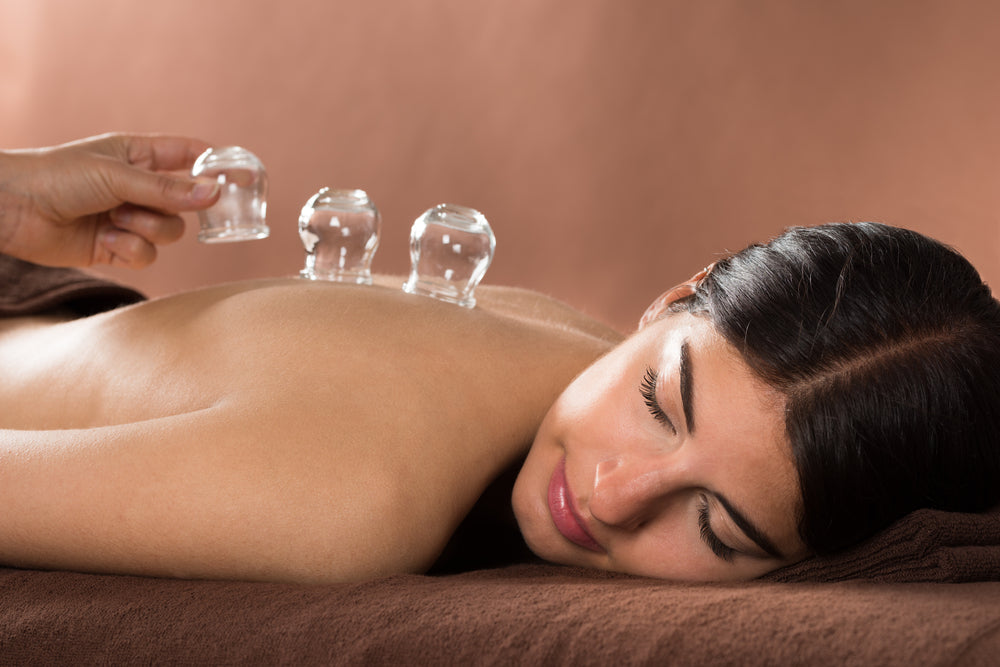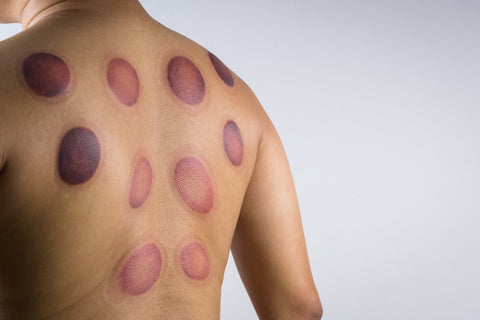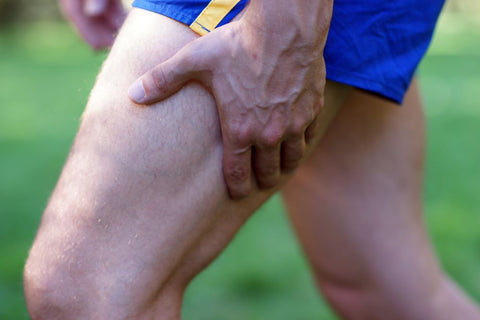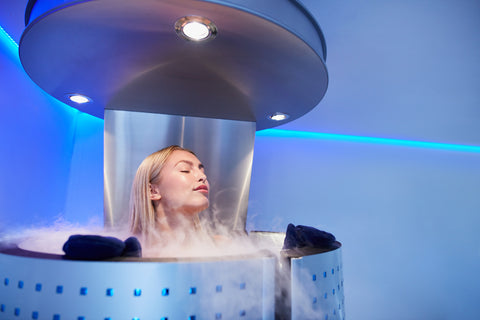Your cart is empty
Free shipping on all US orders


Free shipping on all orders

Have you ever come across someone with these weird circular bruises on their skin and wondered what caused them? Those marks are often the result of an ancient healing practice known as cupping.
And while this might sound new or exotic, it's a practice that has actually been around for thousands of years, used across various cultures, from Egyptian and Chinese to Middle Eastern societies.
In today’s blog, we’ll enter the world of cupping to understand its history, how it works, and much more.
Cupping therapy dates back to ancient times, with evidence of its use found in the tombs of Egypt, the teachings of traditional Chinese medicine, and the practices of ancient Greeks. It was utilized for various purposes, from alleviating pain to treating diseases and even promoting healing by drawing out toxins from the body.

Over the centuries, the technique spread across the world, evolving with each culture's unique healing practices.
At its core, cupping therapy involves placing cups on the skin to create suction. But how does this simple act benefit you? The suction created by the cup draws blood to the area, increasing your blood circulation.
The theory is that this improved circulation at the site of pain or injury can facilitate natural healing and reduce muscle soreness, among other things.
There are primarily three types of cupping methods: dry cupping, wet cupping, and fire cupping. Each has its unique approach and benefits.
Dry Cupping- This method involves simply placing a suction cup on the skin. It's the most common form of cupping, often used to relieve muscle tension and promote blood flow.
Wet Cupping- Wet cupping is a bit more invasive. It involves making small incisions on the skin before applying the cup to draw out a small quantity of blood. This method is believed to remove harmful substances and toxins from the body.
Fire Cupping- In this method, a cup is briefly exposed to fire to create a vacuum before it's placed on the skin. The cooling air inside the cup creates suction. Fire cupping can be particularly effective in deep tissue therapy and improving circulation. This is the most common method in use today.
While the scientific community is still exploring the exact mechanisms of cupping, several theories can help explain its healing effects. One prominent theory is that the suction from cupping increases blood circulation to the area, which can speed up the body's natural healing process.

The enhanced blood flow brings more oxygen and nutrients to the muscles and skin, promoting cell repair and relieving inflammation.
Cupping is also said to stimulate the immune system, encouraging the production of chemicals that reduce pain and inflammation. Some studies suggest that cupping can also activate the lymphatic system, aiding in the removal of toxins and reducing swelling.
First and foremost, cupping works wonders for your blood flow and circulation. The process involves placing cups on the skin to create suction, which draws blood to the area. This increased blood flow can help nourish your muscles and tissues with oxygen and nutrients, leading to an improvement in muscle recovery and performance.
If muscle soreness and tightness after exercise are your constant companions, cupping could offer the relief you're seeking. By targeting specific areas of your body, the suction effect of cupping helps in loosening up tight muscles and breaking up knots.

This process not only alleviates pain and discomfort but also promotes healing of microtears experieinced during exercise.
Imagine how great it’d be waking up the day after a rigorous session, expecting the usual stiffness but finding your muscles surprisingly pliable and pain-free. That's the kind of recovery boost cupping is said to be able to provide, allowing you to get back to training sooner and with greater ease.
Speaking of flexibility, cupping takes it up a notch. Cupping’s ability to relax and stretch muscles contributes significantly to an improved range of motion. For athletes, this improvement helps benefit performance but is also crucial for injury prevention.
Tight muscles are more prone to tears and strains, which can sideline you for weeks, if not months. By incorporating cupping into your recovery routine, you're essentially investing in a preventive measure that keeps your muscles supple and less susceptible to injuries. Imagine executing movements with a newfound fluidity and precision, all thanks to the enhanced flexibility courtesy of cupping.
Sometimes, even with best intentions in mind, injuries still occur. These are an athlete's worst nightmare, but cupping can be a beckon of hope during the recovery phase. This therapy's ability to improve blood flow and reduce inflammation can accelerate the healing process of sports injuries.

Whether it's a sprain, strain, or any connective tissue/ muscle-related injury, cupping can complement your rehabilitation program. By promoting faster healing, cupping not only shortens your recovery time but also ensures that the healing is more complete, reducing the risk of re-injury.
Last but certainly not least is an aspect often overlooked in athletic performance: mental well-being. Cupping therapy has a calming effect on the nervous system, which can significantly reduce stress and anxiety levels.
High-pressure competitions and relentless training schedules can take a toll on your mental health, affecting your focus, mood, and overall performance. By alleviating stress, cupping can help you maintain a clear mind and a positive outlook, ultimately enhancing your mental resilience.
-When comparing cupping to traditional massage, it's essential to note how both methods aim to relieve muscle tension and promote blood flow. However, while massage applies pressure to muscles, cupping uses suction to lift the skin, fascia, and muscles.
This difference in approach means that cupping can access deeper tissue layers than massage alone, providing a complementary effect by encouraging healing in areas that might be overlooked by massage techniques. By integrating cupping into your recovery, you're not just doubling down on the benefits but also addressing muscle stiffness and soreness from multiple angles.

-Foam rolling, another popular recovery method, shares a similar goal with cupping: to alleviate muscle tightness and improve flexibility. However, foam rolling relies on self-myofascial release techniques, which can sometimes be limited by your ability to apply pressure on hard-to-reach areas or by the discomfort that comes with targeting deeply sore muscles.
Cupping, on the other hand, is administered with consistent pressure and can target specific areas without the need for active involvement or enduring additional pain. When paired together, foam rolling can serve as an excellent daily maintenance routine, while cupping can provide deeper, more targeted relief, enhancing the overall recovery process.
-Cryotherapy, known for its use of extreme cold to reduce inflammation and pain, offers a recovery mechanism that seems at first glance entirely different from what cupping provides. However, when looking closer, you'll see that both techniques aim to stimulate the body's natural healing processes. Cryotherapy does so by reducing blood flow to a particular area to decrease inflammation, while cupping increases blood flow to stimulate healing.
Used in tandem, they can offer a powerful one-two punch against recovery times, allowing you to benefit from reduced inflammation and pain while simultaneously promoting faster healing and muscle recovery (similar in principle to alternating hot and cold therapy).
Incorporating cupping into your recovery routine can be a game-changer for enhancing your physical wellbeing and accelerating your healing process. However, to reap the optimal benefits, understanding the when, how, and what of cupping is crucial. Here’s what to know.
The timing of when to incorporate cupping into your recovery routine is paramount. Ideally, it's best to schedule your cupping sessions after periods of intense physical activity or when you're experiencing muscle soreness and fatigue.
This is because cupping helps in relaxing tight muscles, encouraging blood flow, and reducing inflammation, which can significantly aid in your recovery process. However, giving your body time to rest after a session is also vital, as cupping can sometimes lead to muscle soreness due to the intense focus on specific muscle groups.
Therefore, integrating cupping sessions on days when you can afford some downtime or light activity is advisable to allow your body to heal properly.
For the best results and to ensure safety, finding a qualified and experienced cupping therapist or practitioner is essential. Look for professionals who are certified and have a good track record of practicing cupping therapy.

You can start your search by checking local wellness centers, acupuncture and alternative medicine clinics, or asking for recommendations from friends or healthcare providers. A qualified practitioner will not only ensure the correct application of the cups but will also tailor the session to suit your specific recovery needs, maximizing the benefits while minimizing risks.
While professional cupping sessions are recommended, DIY cupping has become increasingly popular, usually for the cost savings. If you decide to try cupping at home, proceed with caution. Begin with purchasing a cupping set that comes with clear instructions and safety guidelines. It's crucial to start slowly, using light suction and limiting the cupping time to avoid adverse effects. Educate yourself thoroughly on the dos and don'ts, and perhaps consider a consultation with a professional beforehand to get personalized advice. Remember, while DIY cupping can be convenient and cost-effective, the expertise of a seasoned therapist can significantly enhance the benefits and safety of your experience.
While cupping is generally safe when performed correctly, there are precautions and potential adverse effects you should be aware of. Common side effects include bruising, soreness, and skin irritation at the cupping sites.
It's also better to avoid cupping if you have certain health conditions, such as skin infections, blood disorders, or if you're pregnant, without consulting a healthcare provider first. Always ensure the skin is clean, and the cups are sterilized to prevent infection. If you experience severe pain, skin damage, or any alarming symptoms post-cupping, seeking medical advice is imperative.
Yes, cupping can be particularly beneficial for athletes suffering from sports-related conditions such as shin splints, tennis elbow, and other overuse injuries. By enhancing blood flow to the affected area, cupping can help reduce inflammation and promote healing. However, it's essential to use cupping as part of a comprehensive treatment plan that may include rest, physical therapy, and other modalities. An even smarter approach is to combine cupping with recuperative nutrition, especially collagen peptides.
The marks from cupping, which are essentially bruises caused by the suction, can vary in color from light pink to deep purple. These marks are normally not painful and usually disappear within a few days to a week, depending on your body's healing process. It's important to note that the presence of these marks is a normal part of the cupping process.
The frequency of cupping sessions can vary depending on your specific condition, goals, and response to the therapy. Some athletes find weekly sessions beneficial, especially during intense training periods, while others may benefit from fortnightly (every two weeks) or monthly sessions.
Cupping can be performed on many parts of the body, including the back, shoulders, legs, and arms. However, there are sensitive areas, such as the face or areas with reduced muscle mass, where cupping should be approached with caution or avoided. A qualified cupping therapist can provide guidance on the most effective and safe areas for cupping based on your specific concerns and body type.
So, the next time you see someone with those odd crop circles on their body, don’t brush it off as a hippie trend. It’s a technique that holds real merit, and something you should look into, especially since it could mean better recuperation for you.